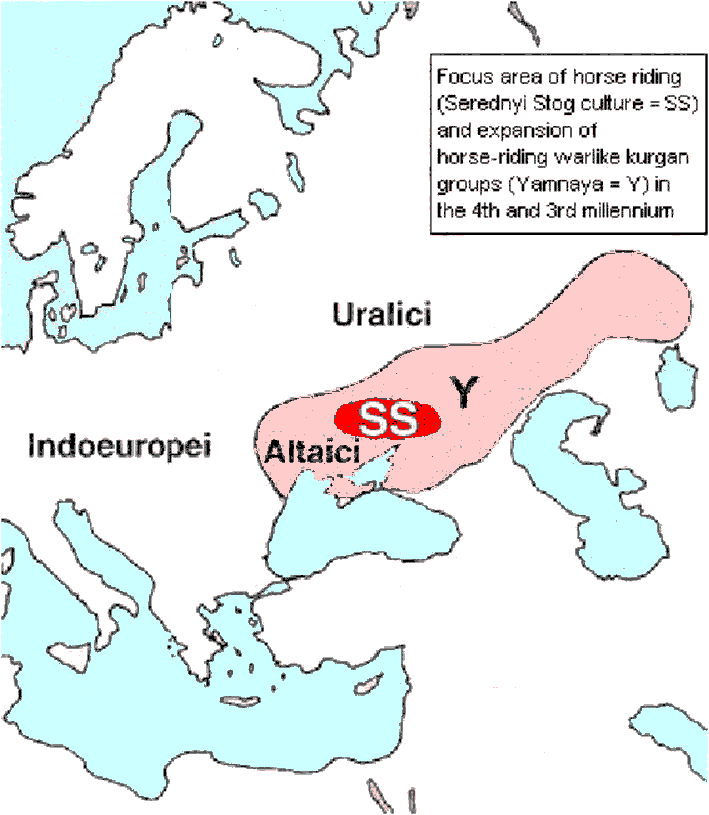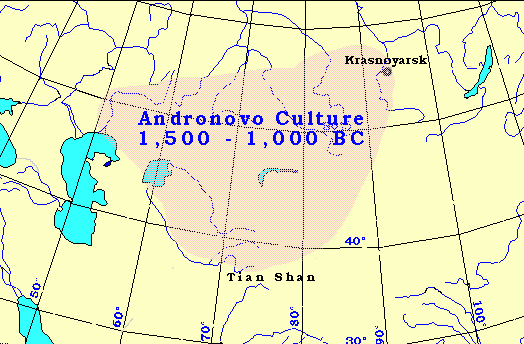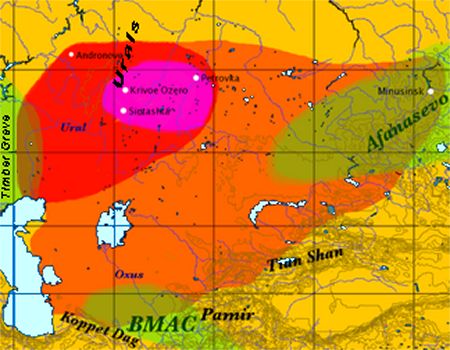Translator's notes
http://kistoria.narod.ru/Bases/Books/Bernshtam_istor_kirgis.rtf
The following excerpts from Chapter 1 of the A.N.Bernshtam's book give a good first-hand description of the Andronov Archeological Culture, which, after it coalesced into a definitive concept, was claimed by both Indo-Iranists and Türkologists, with the Indo-European line dominating the field. In a global picture, the Afanasiev Archeological Culture belongs to the eastern-most fringe of the Eurasian Kurgan Culture of the Eurasian steppes. Since A.N.Bernshtam time, the dating and spread of the Kurgan Cultures significantly developed.
Periodization:
| Afanasiev | 2,500 -1,500 BC | Kurgan Culture, settled or semi-settled, cattle breeding, domesticated sheep, bull and horse, subsistence hunting and fishing |
| Andronov | 1,500 - 1,000 BC | Kurgan Culture, settled and semi-nomadic cattle breeding, domesticated sheep, bull and horse |
| Karasük | 1,000 BC - 500 BC | Kurgan Culture, semi-nomadic, cattle breeding, |
| Tashtyk | 200 BC - 200 AD | Kurgan Culture, nomadic cattle breeding and settled agriculture |
BERNSHTAM A.N.
History of the Kyrgyz and Kyrgyzstan from most ancient times to the Mongolian
conquest
Chapter 1
Formation of cattle breeding economy in Yenisei and ethnogenesis of Dinlins
Instead of the copper, people already learned to cast tools from a bronze, and the improvement in the quality of the bronze allowed to switch to casting of the tools, along with the manufacture of the ornaments. From the bronze, people produced weapons: double-eared axes, knifes daggers, kelts, lance tips, and tools: awl, sickles. Casting became the main technique of manufacturing objects from metal, and forging was used only for reinforcement of the working edge of the tool. The development of the metallurgical manufacture is indicated not only by the composition established by chemical analyses of the bronze, or finds of stone mold forms and assortment of products, but also by the deep underground copper, tin and gold ore mines (Both bronze and bronze casting were brought over to China, to create and then to flourish the bronze casting of Zhou vessels).
The extremely important fact in the development of the Andronov-type culture is a further development of cattle breeding and hoe agriculture. The cattle breeding is demonstrated by the fact that all tombs opened by archeologists contained only bones of domesticated animals: sheep, bull, and horse. In the settlements belonging to that time, the bones of domesticated animals considerably outnumber the bones of the wild animals. But the finds of the wild animals nevertheless testify about hunting, although in comparison with the previous Afanasiev stage it has moved to a secondary role. Domesticated animal gave people not only the meat, but also wool, of which the people learned to make fabrics, evidenced by a small earlap hat made of a woolen fabric, found in one tomb.
| Posting Note - from Nicolo Di Cosmo "The Northern
Frontier in Pre-Imperial China", Cambridge History of Ancient China (p. 903
THE CHARIOT. Numerous studies have suggested that the chariot was imported into China
from the west, possibly around the thirteenth century BC. 38 Wagons and carts were first
made in the Near East in the third millennium BC, as bronze tools and the domestication
of the horse made possible the conception and technical realization of horse-drawn
wheeled vehicles. Chariots should be distinguished from four-wheeled wagons and
two-wheeled carts. Like wagons, carts were used to transport men and goods: they had
solid or spoked wheels and a central axle on which the passenger box rested. Chariots had
spoked wheels and a rear axle on which a box normally holding no more than two people
rested. 39 Recent discoveries related to the Andronovo sites have revealed fully formed
chariots with spoked wheels of the Sintashta–Petrovka culture, which may date, according
to recent studies, as early as 2,026 BC. 40 These are technically and conceptually very
similar to chariots found both in West Asia (such as the Lchashen site, Armenia,
[former] Russian
Federation, in the Caucasus), and East Asia, such as the chariots unearthed at Anyang.
Though based on preexisting models of wheeled vehicles, the war chariot seems to have
been developed by the agropastoralists of the Andronovo culture. This successful culture
was advanced in animal domestication and breeding and mastered the art of bronze
metallurgy to the point that craftsmen were able to manipulate alloys so that the quality
of the bronze would be harder or tougher according to the specific function of weapons
and tools. Indeed, economic success, (mounted horse riding), and the development of the war chariot may have been
the basic factors accounting for the rapid spread of this culture across the Eurasian
steppe from the Urals to South Siberia. |
The developing settled way of life of the Andronov culture people, documented not only by the character of burials, but also by the investigated settlements, created conditions for agriculture. Undoubtedly, the agriculture has emerged from the needs of the cattle breeding, as provisioning of fodder, indicated by a wide spread of sickles which greatly outnumber the tools for plowing. From the tools for plowing were found only the bone mattocks in one settlement. The development of social relations at this stage is marked by a further growth and reinforcement of the patriarchal relations. Typically, individual man's burials are absent. The emergence of separate patriarchal family already shows in the rise of the inequality in property, reflected by the difference in the inventory in different burials. Already are marked richer and poorer burials. A direct result of the development of the cattle breeding and the increase in wealth was a war, which caused a creation of new kinds of weaponry. The weapons already differentiated enough from the tools, and in particular, the weapons became to be better built and decorated (32).
A very important feature of the Andronov culture is its great spread. In particular it points not only to the fact of a developing exchange, but also that the separate patriarchal families were included in the system of the large tribal unions, compensating for the weakness of the separate patriarchal families, who left the clan in the system of private possession of the cattle.
Territory
The Andronov culture is extremely widely distributed. Possibly, its wide distribution was a consequence the political events unrecorded in the archeological monuments, and not just a simple result of the growing exchange. The Andronov culture is spread from the Yenisei to Horesm in the west (33). It should be noted that the Horesm culture is closer to the Eastern European and Northern Caucasian cultures than to the S. Siberian culture (34). The monuments of the Andronov culture are found in Ob, Altai, in the central and eastern Kazakhstan and at the Aral Sea. The objects of the Andronov type are found in the Northern Tian Shan, in Issyk Kul and on r. Sokuluk (35). The Andronov culture of Yenisei is only the extreme eastern variation of a uniform cultural complex in that huge territory. No traces of this culture were yet found to the east and south of Yenisei until now. (This statement still holds true in the 21st century - - Translator's Note)
|
Fig. 8. Map of
European Kurgan (K) and Serednyi Stog (SS) cultures |
Map of Asian Kurgan culture Andronov territory and see Wikipedia map below |
 |

|
Local differences are observed in all the territory occupied by the Andronov culture, and in particular, the cultures of the Altai and Minusinsk territory are closer to each other than the bronze culture of the Kazakhstan type, which is distinct from them. The Tazabagyab culture of Horesm has its local features. The northern Kirgiz bronze has its specific features. Even within the limits of the stated above area we notice monuments from farther areas, in particular from the Eastern Europe. They are the so-called Seymin type kelts from Oka (36).
Thus, the Andronov culture of Yenisei, being fundamentally a result of the spontaneous development of the previous Afanasiev culture, represents an individual expression in the development of the extensive culture from Yenisei to the Urals, brought to life by practice of cattle breeding, which, in a combination with agriculture and hunting, produced a base for the creation of the patriarchal family and the first tribal unions, which unified even if not ethnically homogeneous, then the related tribes of the shepherd-cattlemen.
With the beginning of the 1st millennium BC the mutual relation between the culture of the Minusinsk steppes and the ways of its development have changed. The change is traced in the monuments of the so-called Karasuk type, named so after the name of the r. Karasuk in the area of the village. Bateney in the Minusinsk territory (37).
The continuity of the development of the Karasuk culture from the previous Afanasiev culture is clearly traced by the design of the kurgan and by the tiling of the tombs, which, though, have a distinctive type, for example, like the rectangular fence of stone slabs staked vertically into the ground.
Translator's notes
Neither Herodotus nor Strabo identify Andronovo culture, Karasuk culture, Timber Grave culture, Abashevo culture, Cimmerians, Saka/Scythians, Alekseyevka culture, Thracians, Thraco-Cimmerian, or even the Sigynnae, as Iranian. See for yourself. About Sigynnae [Herodotus 5.9] says: "As regards the region lying north of this country no one can say with any certainty what men inhabit it. It appears that you no sooner cross the Ister than you enter on an interminable wilderness. The only people of whom I can hear as dwelling beyond the Ister are the race named Sigynnae, who wear, they say, a dress like the Medes, and have horses which are covered entirely with a coat of shaggy hair, five fingers in length. They are a small breed, flat-nosed, and not strong enough to bear men on their backs; but when yoked to chariots, they are among the swiftest known, which is the reason why the people of that country use chariots. Their borders reach down almost to the Eneti upon the Adriatic Sea, and they call themselves colonists of the Medes; but how they can be colonists of the Medes I for my part cannot imagine. Still nothing is impossible in the long lapse of ages. Sigynnae is the name which the Ligurians who dwell above Massilia give to traders, while among the Cyprians the word means spears." Poor Herodotus.
Andronovo culture
From Wikipedia, the free encyclopedia
http://en.wikipedia.org/wiki/Sintashta-Petrovka
 |
Map of the approximate maximal extent of the Andronovo culture. The formative Sintashta-Petrovka culture is shown in darker red. The location of the earliest spoke-wheeled chariot finds is indicated in purple. Adjacent and overlapping cultures (Afanasevo culture, Timber Grave culture, BMAC) are shown in green. |
The Andronovo culture is a cover term for a group of Bronze Age cultures of southern Siberia and Central Asia, ca. 2300–1000 BCE. It is probably better termed an archaeological complex or archaeological horizon. The name derives from the village of Andronovo (55°53′ N 55°42′ E), where in 1914, several graves were discovered, with skeletons in crouched positions, buried with richly decorated pottery.
At least four sub-cultures have been since distinguished, during which the culture expands towards the south and the east:
Sintashta-Petrovka-Arkaim (Southern Urals, northern Kazakhstan, 2200-1600 BCE), the Sintashta fortification of ca. 1800 BCE at the Chelyabinsk Oblast; the nearby Arkaim settlement dated to the 17th century; Alakul (2100-1400 BCE) between Oxus and Jaxartes, Kyzylkum desert; Fedorovo (1400-1200 BCE) in southern Siberia; Alekseyevka (1200-1000 BCE) in eastern Kazakhstan. The geographical extent of the culture is vast and difficult to delineate exactly. On its western fringes, it overlaps with the approximately contemporaneous, but distinct, Srubna culture in the Volga-Ural interfluvial. To the east, it reaches into the Minusinsk depression, overlapping with the area of the earlier Afanasevo culture. Additional sites are scattered as far south as the Koppet Dag (Turkmenistan), the Pamir (Tajikistan) and the Tian Shan (Kyrgyzstan). The northern boundary vaguely corresponds to the beginning the Taiga. In the Volga basin, interaction with the Timber Grave culture was the most intense and prolonged, and Federovo style pottery is found as far west as Volgograd.
Towards the middle of the 2nd millennium, the Andronovo cultures begin to move intensively eastwards. They mined deposits of copper ore in the Altai Mountains and lived in villages of as many as ten sunken log cabin houses measuring up to 30m by 60m in size. Burials were made in stone cists or stone enclosures with buried timber chambers.
In other regards, the economy was pastoral, based on horses and cattle, but also sheep and goats, with some agriculture in clear evidence.
Arkaim in Russia is believed to have been constructed by Sintashta-Petrovka tribes some 4000 years ago. The Andronovo culture has been strongly associated with early Indo-Iranian culture. In particular, it is credited with the invention of the spoke-wheeled chariot around 2000 BCE; Di Cosmo (p. 903) referring to finds related to the Andronovo culture from "as early as 2026 B.C."
Sintashta is a site on the upper Yaik River. It is famed for its grave-offerings, particularly chariot burials. These inhumations were in kurgans and included all or parts of animals (horse and dog) deposited into the barrow. Sintashta is often pointed to as the premier proto-Indo-Iranian site, and that the language spoken was still in the Proto-Indo-Iranian stage. There are similar sites "in the Volga-Ural steppe" (Mallory).
Successors: The Sintashta-Petrovka culture is succeeded by the Fedorovo (1400-1200 BCE) and Alekseyevka (1200-1000 BCE) cultures, still considered as part of the Andronovo horizon.
In southern Siberia and Kazakhstan, the Andronovo culture was succeeded by the Karasuk culture (1500-800 BCE), which is sometimes asserted to be non-Indo-European, and at other times to be specifically proto-Iranian. On its western border, it is succeeded by the Timber Grave culture, which partly derives from the Abashevo culture. The earliest historical peoples associated with the area are the Cimmerians and Saka/Scythians, appearing in Assyrian records after the decline of the Alekseyevka culture, migrating into the Ukraine from ca. the 9th century BCE (see also Ukrainian stone stela), and across the Caucasus into Anatolia and Assyria in the late 8th century BCE, and possibly also west into Europe as the Thracians (see Thraco-Cimmerian), and the Sigynnae, located by Herodotus beyond the Danube, north of the Thracians, and by Strabo near the Caspian. Both Herodotus and Strabo identify them as Iranian.
References:
"The Northern Frontier in Pre-Imperial China", Cambridge
History of Ancient China (pp. 885-966) ch. 13, Nicolo Di Cosmo
J. P. Mallory, "Andronovo
Culture", Encyclopedia of Indo-European Culture, Fitzroy Dearborn, 1997.